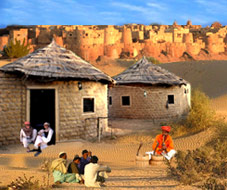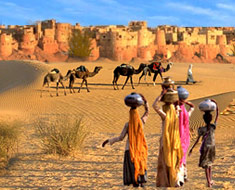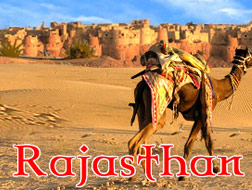 The history of Rajasthan dates back to pre-historic times as one finds settlements dating to this period in Rajasthan. Archaeological excavations establish a relation with the Harappan culture trailing back to 1000 BC. Rajasthan has also had Paleolithic settlements as one finds paintings in some areas of Rajasthan tracking back to this period. Later, the first Aryan settlement was also discovered here at Dundhmer, the modern day Dundhar. Ancient Hindu scriptures like Mahabharata and Ramayana make references to the holy city of Pushkar in Rajasthan. Known as the "Land of Princes", several dynasties have ruled here and contributed to the development of Rajasthan. Rajasthan fell under the empires of Magadha, Kushanas, Guptas, and Mauryas. The formation and development of Rajasthan is contributed to several tribes, like the Rajputs, Jats, Bhils, Ahirs, Nath, Gujars, and Meenas.
The history of Rajasthan dates back to pre-historic times as one finds settlements dating to this period in Rajasthan. Archaeological excavations establish a relation with the Harappan culture trailing back to 1000 BC. Rajasthan has also had Paleolithic settlements as one finds paintings in some areas of Rajasthan tracking back to this period. Later, the first Aryan settlement was also discovered here at Dundhmer, the modern day Dundhar. Ancient Hindu scriptures like Mahabharata and Ramayana make references to the holy city of Pushkar in Rajasthan. Known as the "Land of Princes", several dynasties have ruled here and contributed to the development of Rajasthan. Rajasthan fell under the empires of Magadha, Kushanas, Guptas, and Mauryas. The formation and development of Rajasthan is contributed to several tribes, like the Rajputs, Jats, Bhils, Ahirs, Nath, Gujars, and Meenas.The Age of the Rajputs
Rajasthan, today, includes almost the entire Rajputana. According to Hindu mythology, the Rajputs are the descendants of the Ksatriyas, or the warrior clan of Vedic India. The Gurjar Pratiharas were the earliest of Rajputs to rule Rajasthan since 640 AD. The rise of Rajputs in the 6th and 7th centuries, as a formidable force, paved way for extensive development of Rajasthan. There were several Rajput clans, like the Sisodias, Rathores, Chauhans, Kachhwahas and Bhatis, who empowered Rajasthan considerably.
It was in the 9th and 10th centuries that the Rajputs rose to prominence and several chivalrous men laid their lives to protect their honor and land. In the 12th century, the valiant Rajputs were the ones who fought fearlessly the Muslim invaders like Mohamed Ghori, whose prime interest was to loot and raid the wealth of India. In the battle of Tarain (1911), Prithviraj Chauhan fought bravely and became a martyr while trying to save the honor of his land.
It was during the Mughal era that several Rajput states agreed to the supremacy of Mughals and joined the Mughal court as important ministers. It was Akbar, the Great Mughal Emperor, who realized that the proud Rajputs are indispensable if one has to consolidate their rule in India as they are chivalrous warriors and excellent administrators. It was the great Maharana Pratap of Mewar who was too proud to forge an alliance with the Mughals and agree to their supremacy.
The Rajputs reasserted their power with the decline of Mughals. However, soon they came under attack from the Pindaris and Marathas who rose to prominence in the 18th century. In the 19th century, the Rajputs maintained local autonomy while agreeing to British sovereignty as a whole. It was at independence of India that the erstwhile Rajput kingdoms and British provinces were merged to form the state of Rajasthan as it stands today.










